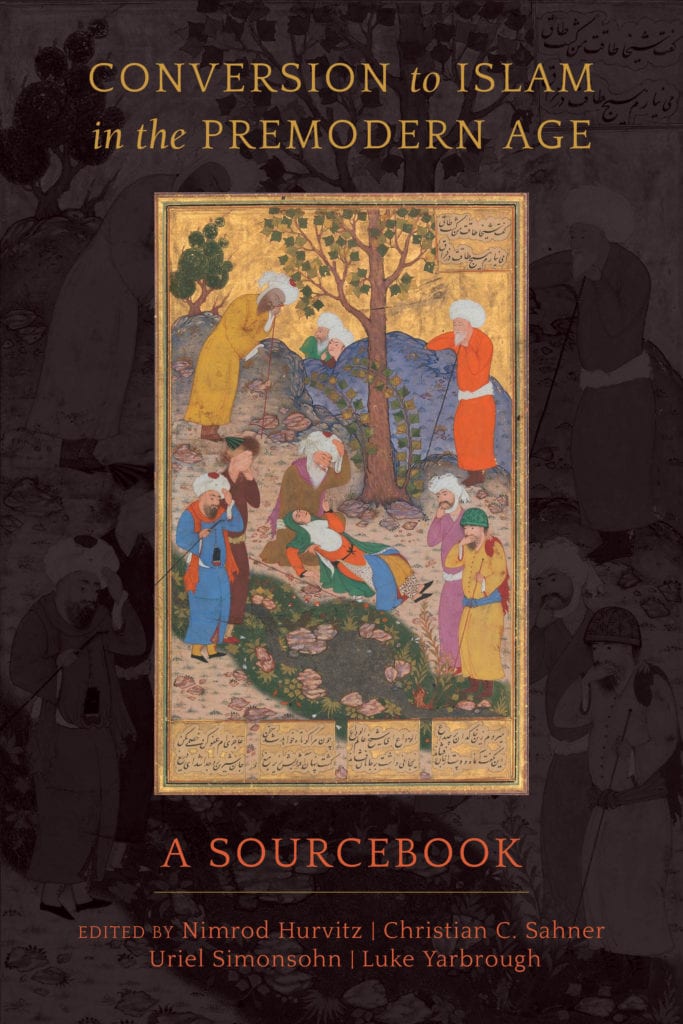This post is part of our #MESA2020 blog series. Learn more at our MESA virtual exhibit.

For this year’s virtual MESA conference, Luke Yarbrough joined us to talk about the new co-edited book Conversion to Islam in the Premodern Age and why understanding Islamic conversion is a crucial part of world history.
Luke Yarbrough is Associate Professor of Near Eastern Languages and Cultures at the University of California, Los Angeles and the author of Friends of the Emir: Non-Muslim State Officials in Premodern Islamic Thought. He is co-editor of Conversion to Islam in the Premodern Age, along with Nimrod Hurvitz, Christian C. Sahner, and Uriel Simonsohn.
UC Press: What makes conversion to Islam a phenomenon of such significance to human history?
Luke Yarbrough: About a century ago, modernization theory was predicting that religion would become obsolete and slip off like a worn-out robe as humanity grew in technological sophistication. Obviously, that’s not what has happened. The major “salvation religions” are still seeking new adherents and finding them in large numbers.
So conversion, and conversion to Islam in particular, is happening intensively in our own time. It is helping to make Islam the fastest-growing major religion in the world and possibly soon the largest. But Islam enjoys pole position only because of its prodigious growth in the past, in which conversion also played a significant role. For Muslims past and present—not for all of them, of course, but for many—becoming and being Muslim has been a big deal: a central component of their identity, ways of imagining the cosmos, daily habits, social life, and politics.
So even if you’re not a history nut, these factors alone should make conversion to Islam matter to you if you’re someone who wants to understand the world we inhabit today. And since Islam was, as Ernest Renan famously (though misleadingly) put it, “born in the full light of history,” we have a wealth of surviving sources that can help us puzzle out what conversion to Islam has been all about and what difference it has made to humans.
UC Press: What unique contribution does Conversion to Islam in the Premodern Age: A Sourcebook make to the scholarship in this area?
Luke Yarbrough: To put it simply, there’s nothing else like this book out there in the scholarship on conversion to Islam. A lot of the most brilliant work on the phenomenon—books by scholars like Richard Bulliet and Richard Eaton—has been done in an analytical fashion that cleverly discerns the trends and processes that were at work underneath what the sources tell us. Other scholarship on conversion has, naturally enough, looked at it mainly from Muslim perspectives, or has proceeded with dogmatic, outdated understandings of what conversion is.
This book makes a few new moves by bundling almost 60 different primary sources that deal with conversion, edited and translated by some of the world’s leading scholars. First, it foregrounds the way people have represented the process of becoming (or not becoming) Muslims: how they’ve used language to infuse conversion with a huge range of meanings. Second, it puts a fairly large number of these representations in the hands of the English-speaking reader—especially students—for the first time. It’s a bit like giving out the source code for something that was previously only available as an app. And third, it includes as many voices and perspective as we could track down, though we wish we’d managed to get even more. Not just what educated Muslim men wrote about other men in Arabic religious texts, but views from other religious perspectives, views from oddball sources like entertaining literature and poetry and imperial records, views in a dozen different languages emanating from West Africa to China and Malaysia, and views that foreground women, children, and people who blurred the lines between Muslim and non-Muslim. All of it should help people figure out for themselves what they think about the big debates that still swirl around conversion to Islam.
UC Press: What do you hope scholars and students will take away from this text?
Luke Yarbrough: We hope that the people who use our book will understand that conversion to Islam is—precisely because it’s so widespread and historically important—not a simple thing that can be captured with any one model, theory, or set of generalizations, no matter how recent or sophisticated.
The ways people construed conversion and the social effects that it had were quite unpredictable, and it intersected with other historical processes and ways of describing the world in a million different ways. We hope that our book will help students and scholars feel equipped to seek their own well-informed conclusions by examining the kaleidoscopic range of accounts our 50+ contributors came up with. Ideally, they’ll keep following the trails of breadcrumbs that begin in this book in the directions of their own interests. That’s why each of our contributors give their top suggestions for further reading.

